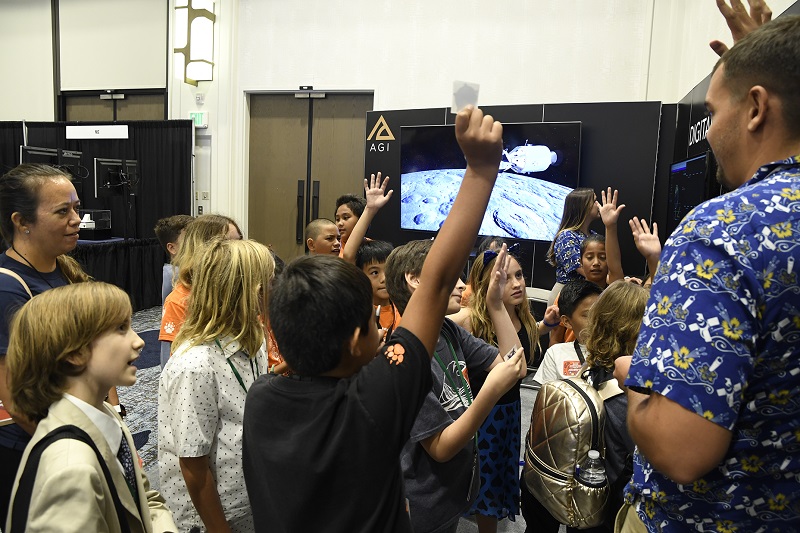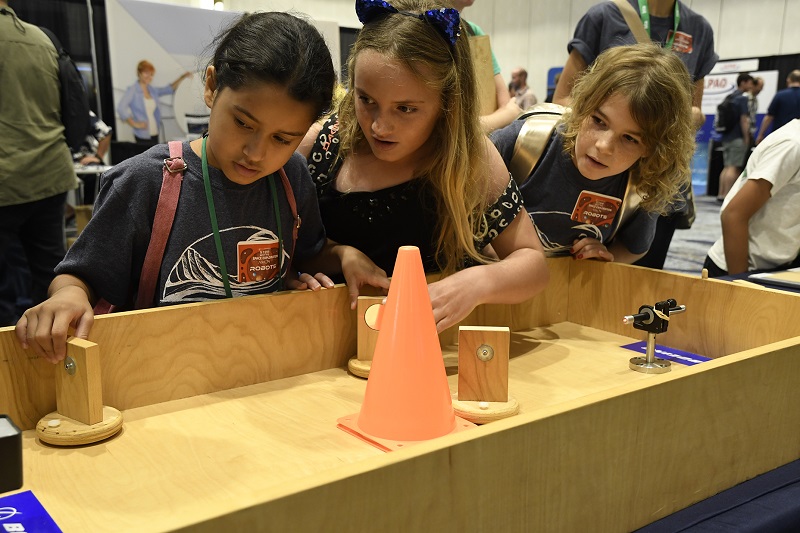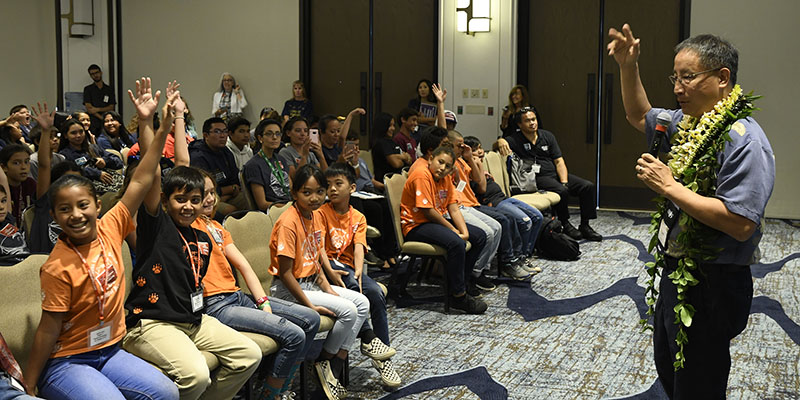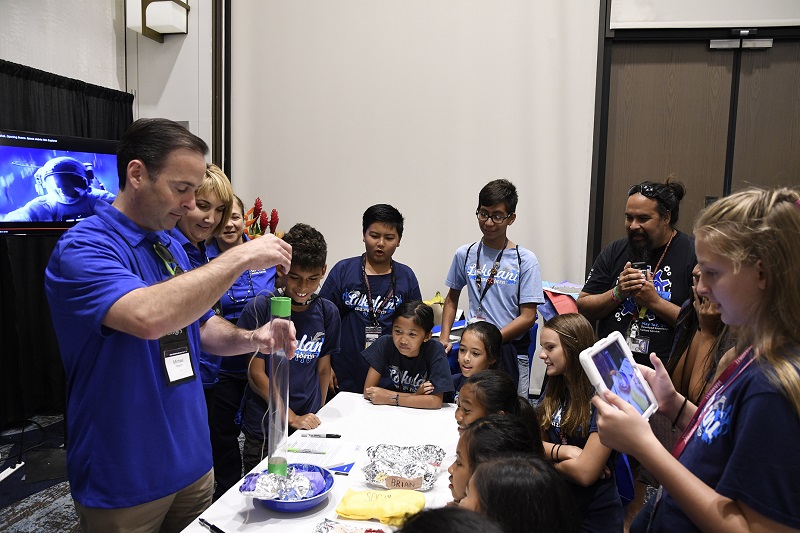One hundred and fifty middle and high school students and STEM (science, technology, engineering, mathematics) educators were welcomed by the Advanced Maui Optical and Space Surveillance Technologies (AMOS) Conference on September 20th at the Wailea Beach Resort, Maui.
The conference and the Space Exploration Student Session, presented by Maui Economic Development Board (MEDB), thrilled attendees who got to meet astronaut Dr. Edward Lu and experience hands-on, space-related presentations by the AMOS exhibitors.
Alex Ridgeway, a senior system engineer from Analytical Graphics Inc (AGI), Tokyo, explained the AGI activity set up for the students. “We showed the students a video of a lot of objects in space and how we keep them safe. AGI makes an app showing satellite locations that anyone can download and see what satellites are above them. The students grasped the importance of tracking satellites and space debris so they do not hit each other and create more debris. Learning the significance and consequences of what is happening in outer space and how it all relates to our everyday lives is key to helping students expand their future career choices.”
“Working with middle and high school students is exciting because it opens up new opportunities that they may never have thought about. Plus, as long as humankind continues to use space, students worldwide need to become excited about space-related careers,” added Ridgeway.

Dr. J. D. Armstrong, Education Outreach Specialist, University of Hawaii Institute for Astronomy (IfA), explained how the IfA exhibit had the students look at near-Earth asteroid data. “Basically, we had four images of the same part of the sky and we played them like a movie. The students then looked for the moving objects which were the near-Earth asteroids. I also had a meteorite so they could see a real piece of what they are looking for, a 3D printed model of Vesta and Itokawa 9 asteroid and comet. I brought and shared a model that NASA made of a comet which matched color, shape and density of the real object.”
“The way the industry is growing, it is important for us to interact with the students at the Student Space Exploration Session.” said Alex Walker of Lockheed Martin, who invests a lot in the next generation. “We look forward to this every year. It is our hope to inspire the next generation of space explorers to come and work for Lockheed Martin someday.”
David Bloyer, Deputy Maui Site Director for Boeing LTS said, “At our first exhibit we presented the properties-of-light demonstration using filters, polarizers and lenses with incandescent light and lasers. The second exhibit was a simulated optics table where we explain some basics about the configuration of the AEOS telescope and how collected light reaches the sensors on optics tables. The participants used a laser source and mirrors on pucks to achieve a goal of sending light to a simulated sensor. There is a team aspect to this, as there are two tables and the participants will work on two teams to achieve complex light-routing objectives. The third exhibit was a noise cancellation lab where students learned with a hands-on laboratory demonstration about the controllable properties of sound and how noise cancellation works.”

Lori Ann Koyama, Lahaina Intermediate STEMworks™ Media Production and Graphics teacher, said, “Events like this expose our students to the unknown and excite them into future STEM careers. Gaining firsthand knowledge about science applications that are needed for the next century will drive students the most.”
“Many of our group did not know most of these organizations existed and that there is such a thing as space debris, something we all have to be concerned about. That’s important!” Koyama continued, “Plus, they learned that a lot of the satellites in space are responsible for their daily activities like cell phone and wi-fi use, which tremendously interested them. At one of the exhibits they clearly saw the importance of international cooperation to help keep space safe.”
“Additionally, the students got to meet an actual astronaut, Dr. Lu.,” Koyama said. “They asked questions about his time in space and also heard how he later led the Advanced Projects Group at Google, which built imaging and data-gathering systems for Google Earth and Maps.”

Dr. Lu, currently the Executive Director of the Asteroid Institute, served as a NASA astronaut for 12 years. He flew aboard the Space Shuttle twice, flew on the Russian Soyuz to the International Space Station and has logged over 206 days in space. He received numerous commendations for his space service, including NASA’s highest honor, the Distinguished Service Medal.
“It takes 90 minutes for the Space Station to orbit the earth at 18,000 miles per hour,” Dr. Lu explained to the students. “So, going that fast, if we hit space debris, it is a real problem. That is what this conference is all about. People from all nations working together to keep space clean and safe.”
Lahaina Intermediate 7th grader, Kai Shively said, “Meeting astronaut Lu was so exciting. He explained about how dangerous space debris is for the Space Station and other satellites in space. When he was on the Space Station he felt debris hit a window, but luckily it did not do much damage. However, when Dr. Lu did his spacewalk, he saw other dents from debris and realized what an enormous problem it is.”
Shively added, “After the discussion at AGI and other exhibits at AMOS, I want to be an engineer to help take care of our space environment. Debris is serious. Dr. Lu told us about his experience with debris and now I realize that something has to be done. I want to be part of that.”
Taika Swearinger, 7th grade, exclaimed, “I love science! It is so much fun to be here! I learned a lot about different jobs in space and how we need to clean up the space debris ‘now’ because it is really dangerous to all our lives, as well as to all the satellites in space that cost millions of dollars. I’m so grateful to Dr. Lu and all the industry professionals who made me aware of a whole new world of space exploration that I want to learn about.”
Swearinger mentioned the AGI exhibit as a favorite. “After viewing the AGI software, I realized that we are the protectors of Earth and so we need to care for it by also making space safe.”
Melinda White teacher at Hawaii Technology Academy where they have been integrating progress-based learning and supporting students in a blended learning environment. “This AMOS session, with hands-on activities, is a cumulative event-experience after a month and a half semester of learning space science in the classroom. The students met career professionals in astronomy and space-related careers. In school we did a lot with prisms, mirrors, and cutting-edge technology, so the highlight at Student Space Exploration was meeting and asking questions of an astronaut and industry experts. The students will write a narrative non-fiction essay to highlight their experience at AMOS.”
Asher Kirgdon, Hawaii Technology Academy, grade 5, shared what he learned, “Today I learned about different jobs in space. I learned a lot about telescopes, but mostly how we have to protect our space environment from space debris. I saw that there are extraordinary events taking place in outer space and learned what astronauts do, and how telescopes help us see outer space. We were shown all the space debris in a software video and discussed the significance of it in our daily lives. I am very concerned about the people on the International Space Station. I want them to be safe and able to achieve all the scientific experiments they are doing for the betterment of our planet Earth. This event confirmed that I want to be an astronomer or engineer.”
Jennifer Suzuki, Maui Waena Intermediate School STEMworks™ advisor, said, “This day allows my students to experience real-world jobs and also makes the world bigger. Half of them did not even know there is space trash. It makes them more aware, builds confidence, changes career thoughts, maybe inspires the next astronaut. Who knows? If it wasn’t for MEDB on this island my students would not have the opportunities they have, changing so many of their lives by giving them numerous inspirational experiences. I have seen my students move on to extraordinary careers due to aspirations they received at MEDB events.”
Holden Suzuki, Maui Waena Intermediate School 7th grade, was also impressed with all he learned “It is really an amazing thing to attend the Space Exploration Student Session, especially on Maui which is somewhat a secluded community. I want to go into astronomy and look at space, the most interesting thing you can do. Being here at AMOS inspires me even more to achieve my goal.”

Aaron Omuro, a 6th grader at Maui Waena Intermediate School, listed the SAIC (Science Applications International Corporation) exhibit as his favorite hands-on experiment.“We did experiments that showed us ways to build satellites to prevent debris from ruining them. We learned that being struck by one of these objects is dangerous to our valuable assets in space and to the astronauts. Satellites and spacesuits must be designed with materials that are resistant to impacts. I want to continue to think about this issue, and help keep space safe for people and satellites.”
Mark Cunningham, Iao Intermediate School science teacher and STEMworks™ advisor, believes the Student Space Exploration day inspires more students than any other event he has been to over the years. “Students come back so excited. I have had a number of students just from this event change their science project to include physics and astronomy because of the equipment they see here and the scientists they interact with.”
“I am sure the Students Space Exploration Session motivates them to move on to pursuing careers in STEM.” noted Cunningham. “The students receive a sense of what is really possible in the world.”
STEMworks™ advisor at Molokai Middle School, Kumu ‘Iolani Kuoha, ‘O Hina I ka Malama Hawaiian Language Immersion Program teacher said, “I can feel the energy in my students, they are so excited to be here! We toured the exhibits and the students asked the professionals questions. They did hands-on experiments, and learned what the organizations are doing. They are learning so much to share with their classmates on Molokai. This is great exposure, especially for the girls. The students have a science fair coming soon, so the hands-on STEM activities are giving them many ideas.”
Kuoha noted, “We all have a connection to where the communication satellites are in space. That’s where we are getting our signals from for Direct-TV, wi-fi, internet and numerous everyday conveniences. We need space, satellites, and science to connect with things in our lives on a daily basis. Our students may be creating jobs in the future with technologies that do not even exist yet. That’s pretty cool!”
“My favorite exhibit was the thermal infrared imaging exhibit at Lockheed Martin, Ciera-lee Ka’apuwaihiwalani Davis, Molokai 7th grade, added. “We experimented with a camera to learn how heat transfer works. The visual impact was huge and fun. We saw how the change of energy is indicated by an increased temperature. It is a privilege to come to AMOS and see people from all nations working together to keep space clean and safe for all of us.”
“I love science and space!” exclaimed ‘Ohi’aku Ritte-Camara-Tangonan, Molokai 8th grade. “This event has taught me many things about the universe. It was exciting to meet astronaut Dr. Ed Lu and learn about the education needed to become an astronaut and what he did on the International Space Station. Education is the most powerful weapon we can use to change the world for good.”
